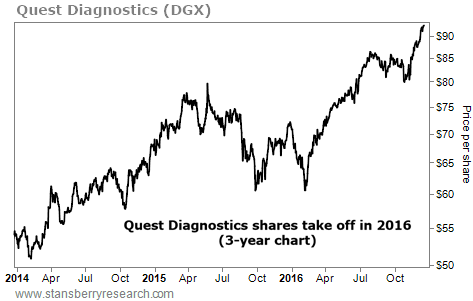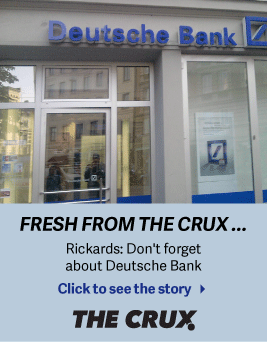| Home | About Us | Resources | Archive | Free Reports | Market Window |
A Big Warning Sign on Stocks From One of Our Top IndicatorsBy
Tuesday, December 20, 2016
Uh-oh...
For years, I've been extremely bullish on the stock market. And I still am, over the next year or two.
However, in the short term, one of our top indicators is giving us a big warning sign...
This indicator tells us that the stock market is getting "overly loved" by investors – and this is a bad thing.
You see, typically when a market gets "overly loved," it often struggles to rise (at best) or even falls (at worst) over the following three months or so.
Let me explain...
"Overly loved" is not a technical term, of course. It's a simplified way of describing investor sentiment...
If you've read my writings in the past, you know that I want to buy an investment when it's HATED.
(For example, you would have wanted to buy U.S real estate in 2011, when it was hated, as opposed to 2007, when it was loved.)
One of our favorite indicators for whether an asset class is hated or loved is what's happening with the "shares outstanding" of exchange-traded funds (ETFs).
When investors get excited about an asset class, money flows into its ETFs. When a LOT of money flows in, those ETFs have to create more shares. And this is where the problem comes in right now...
"In the past few days, we've noted that several of the major-index ETFs have taken in their largest daily inflows of the year," my friend Jason Goepfert of SentimenTrader.com wrote this week. That includes the funds that track the S&P 500 (SPY), the Dow Jones Industrial Average (DIA), and the Nasdaq-100 Index (QQQ)...
Jason explained that the shares outstanding in all of these major ETFs "have seen rapid growth in the past week. The past several weeks, actually. Over the past 30 days, the funds have grown their shares outstanding by more than 13%, the second-fastest pace of the bull market." What does this tell us? Jason gives us the answer:
While the market could struggle in the near term based on this indicator, Jason normally sees this indicator as most valuable for finding market bottoms, as opposed to market peaks...
Still, it's a warning sign that the market could struggle in the next few weeks, or even months. I don't think this means we're at the end of the great bull market. I don't think it's time to sell everything and batten down the hatches. To me, this probably means that we're near the end of the Trump rally... that it's time for the Trump optimism in stocks to burn off.
Stocks will likely take a break and let all of this investor optimism wear off a bit... before the bull market resumes in full again.
Good investing,
Steve
Further Reading:
"The spread between optimism and pessimistic indicators is getting stretched," Jason told Steve recently. And that means in the short term, we could see some tough weeks for stocks before a rally resumes. Read more about Jason's valuable research in market sentiment right here.
Steve sees more upside ahead – and Dr. David "Doc" Eifrig agrees. In a recent essay, Doc reviewed several indicators that show the economy is still growing today. Learn why you shouldn't invest based on politics – and what you should do instead – here.
Market NotesANOTHER WINNER IN HEALTH CARE Today's chart highlights the massive, ongoing uptrend in health care stocks...
For years, our colleague Doc Eifrig has argued that health care stocks are "absolutely the safest long-term trend in the market." As Baby Boomers continue to age, they will inevitably spend more and more money on medicines, medical products, and health services.
One company profiting from this megatrend is Quest Diagnostics (DGX). The leading medical-testing firm in its field, Quest serves about half the hospitals and doctors in the U.S. The company has more than 2,000 locations around the country.
As you can see in the chart below, DGX shares have climbed more than 75% in the past three years and are now trading at a fresh multi-year high. This trend shouldn't reverse anytime soon... And that's great news for Quest and its shareholders...
 |
Recent Articles
|



